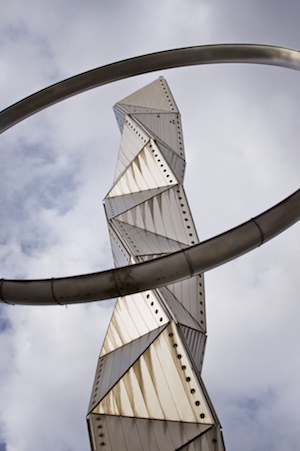Art Tower Mito
Over the next few weeks, I’m planning to mention a few events that you may want to go to, but I will not likely have time to see myself. Previews rather than reviews let’s call them.
I’ve mentioned the use of manga in Japanese art in the past, and I’ve also likely mentioned that it is something of a personal bugbear of mine. Not because I have a problem with manga appearing in art or being used by artists, but because I have a problem with its perception outside of Japan. Too often, it becomes a part of that persistent notion that Japan is a country caught between so-called old and new values; that it is a “quirky” place full of quirky people and ideas. These are the stereotypes that are trotted out again and again.
Of course, businessmen do, in fact, read manga on the trains. Women do sometimes talk on cellphones while wearing kimonos. The technology industry does love its robots just as much as the neighbourhoods love their festivals. But these things are only indicators of the strangeness of Japan insofar as they appear strange to non-Japanese — a fact that Western observers are apt to forget. Japan doesn’t need to be defined in terms of how it doesn’t fit into a Western framework. Manga is not a defining Japanese characteristic, it is a part of a rich and diverse popular culture.
The “Manga Realities” exhibition at Art Tower Mito is a show I’d love to check out precisely because it appears to be doing what the name says: looking at the realities of manga. From the website:
“This exhibition puts the spotlight on nine popular manga titles that have emerged since 2000. The aim is to introduce narrative manga as it stands today – as the culmination of decades of development since the postwar period. Exhibitions of manga generally focus on original drawings by manga authors. In this exhibition, which is produced in close cooperation with authors, editors and others involved in the manga production process, the focus is on creating experiential, three-dimensional presentations of the worlds depicted in manga.
“For years, manga artists have freely incorporated elements from other artistic forms, such as film and literature. Manga makes regular use of symbolism, and has developed into a cultural industry encapsulating much more than children’s entertainment. Manga have been made on themes as diverse as sports, science fiction, gambling, love, violence and sex. As a cultural industry, manga reached its peak in the 1990s. Since 2000, the diversification of the manga readership has been mirrored by even greater diversification of themes and forms. It has got to the point where it is no longer possible to talk of a single, all-encompassing concept of ‘manga.’”
This is the kind of show that you can only get in Japan. One that will take manga seriously and not attempt to exoticize it. With any luck, it will be a show that looks at it as both a drawing-based art form, as a narrative form and as a cultural business. And all of this leads up to the artists who have chosen to make use of manga for its impact on pop-culture, just as manga itself has turned to other forms of media in the past — from sumi-e to television.
Three-dimensional representations of the worlds depicted in manga? Well…I guess they need something to entertain the fans.
Mito is a bit far, however. It will take you a good hour or two to get there, depending on the train you take. And I make no promises on whether or not there will be English language materials available. But if you’re up for it, Mito makes a great day-trip, and the show sounds promising.
-Owen Schaefer
Twitter
Photography









